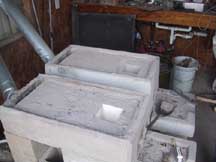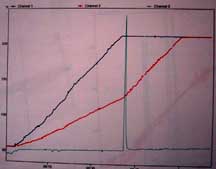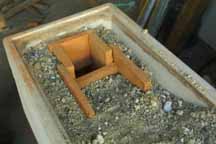

HELPS Plancha Stove Jutiaupa Mod With Inverted Pyramid
See also Ron Larson's Questions
Don O'Neal HELPS International March 2003
I have just rerturned from an extended trip to Guatemala and see a lot of interest in the inverted pyramid and some references to what HELPS is doing in this regard. Here is an update.
1. The HELPS stove plancha is 14" by 28" and therefore has different heating characteristics from the 22" square plancha tops. I didn't need additional heat in the front or to the sides. Here was the original configuration shown in my test lab. The gap under the plancha, front to back, was 1 inch.
In this configuration the gases are collected in a slot in the back, to prevent all gases going down the middle. Front and sides of the combustion chamber were no problem.
 |
 |
The curves show the heating rate on the front and rear pot holes. The rate of heating on the back pot hole is about half that of the front. At the green marker spike, the front pot starts to boil and the pots are reversed. Back to front and front to back. The boiling pot, now on the back pot hole continues to boil and the cooler pot, now on the front, starts to heat at a rate approximating the original front pot. The women seem to prefer a hotter area and a simmering area. In fact there was little problem with this configuration until the ladies tried the 'Jutiaupa Mod'.
2. This design was later changed to sort of an sort of a one-sided inverted pyramid, although I never thought of it that way. Just a way of shifting some of the heat to the back.
 |
 |
 |
3. This was first done in Jutiaupa, Guatemala and has become known at HELPS as the 'Jutiaupa mod'. Note in the right photo there is some shaping of the pumas to direct more gases into the corners and that the ramp ends under the back pot hole. There is still a one inch gap in front of and to the sides of the combustion chamber and in front of the exhaust slot.
4. Word spread as all ladies liked it better. So much so that we went back and retrofit all stoves in the field. This was a big effort but we were interested in consistency of all installations. There are now 750 stoves in use with the Jutiaupa mod.
5. There is still a difference in heating rate front to back. Where previously the heating rate in back was about 50% of the front, it is now 75% of the front. The front dropped a little and the back came up a little. Test show that when considering both pots the efficiency is the same. Efficiency test of just the front would obviously not be quite as good.
Regards to All
Don O'Neal
HELPS International